




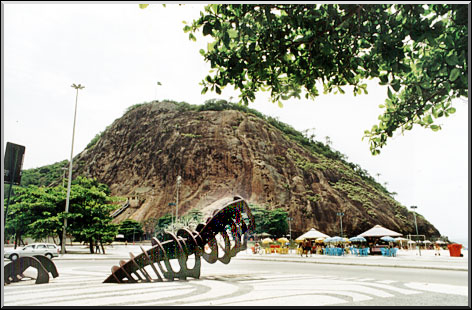 |
| Brassavola tuberculata Hook |
| Synonyms: |
|
- Brassavola
perrinii (Rchb.f.) Lindl. - Brassavola fragrans Lem. - Brassavola gibbsiana Williams. |
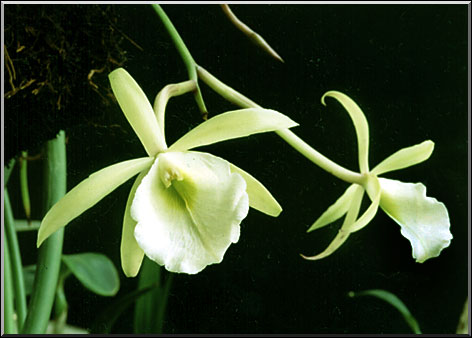 |
Brassavola tuberculata Hook used to grown at all sea shore of Rio de Janeiro city, where it has been found by Harrison, at about l825, in a rock in Botafogo quarter. The flowers are white-greenish or white-yellowish and the lip is light green in its base. Each inflorescence brings 1 or 2 flowers and has a pleasant scent during the nocturnal period. The blooming season starts in the winter and can extend until the springtime. However, it can, eventually, bloom in any time of the year. The leaves, dependent on the climate conditions, can vary the thickness and length since 12cm until 24cm. They are terete, deeply grooved and fleshy and vulgarly known as "rat tails", although that term can be used also to another genera. |
|
Still today,
in the open Atlântica Avenue, in Leme quarter, in Rio de Janeiro city, more exactly in Leme Hill, a population of Brassavola tuberculata bravely resists, |
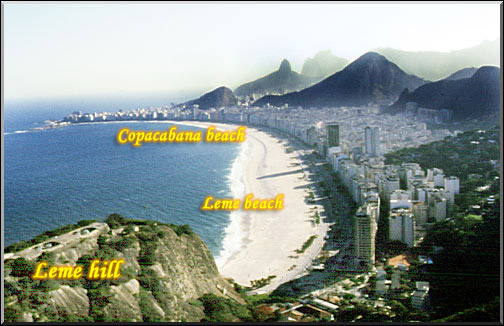 |
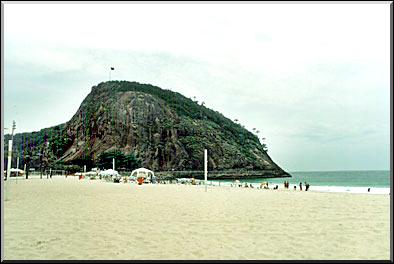 |
|
growing sometimes directly on the uphill rocks exposing the roots and leaves, sometimes in the crevices of the rocks, without any substrate or over an heap of vegetal matter hold by a species of cactus that is its companion in this habitat. It grows as rupicola at the whim of the sun, however the marine wind and humidity compensate the hostility of the environment. |
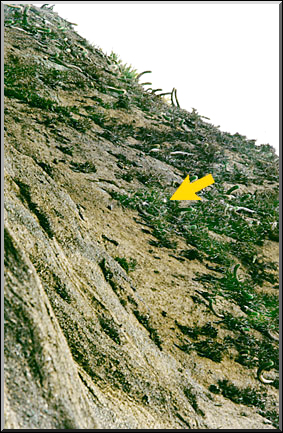 |
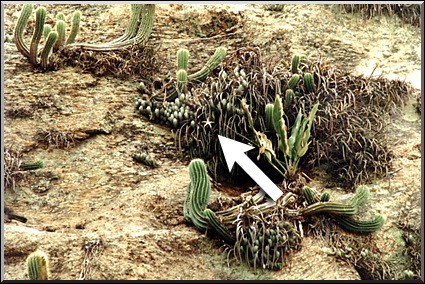 |
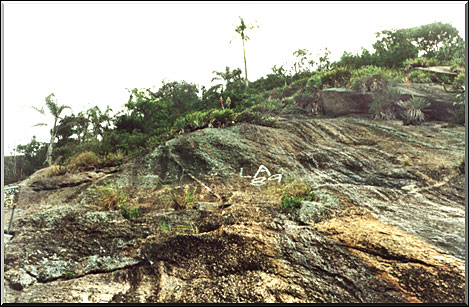 |
It is interesting to point out that the side of the hill which faces the sea, thus more exposed to direct marine wind, does not present, nowadays, any specimen, let us believe that it does not like strong straight wind or perhaps, as the face is not the most steep side, this species is more susceptible of being collected there. |
| The opposite side, much steeper, receiving sunbeam all day round, is much richer in number of specimens presenting a still big population of small and big tufts which sprout of the rock and stay there hanged. | 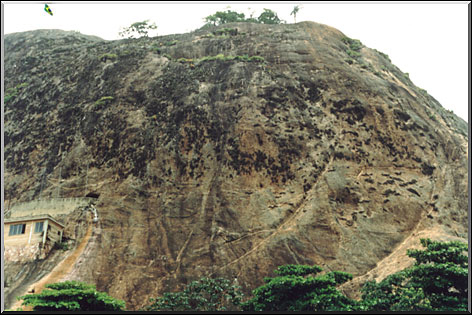
|
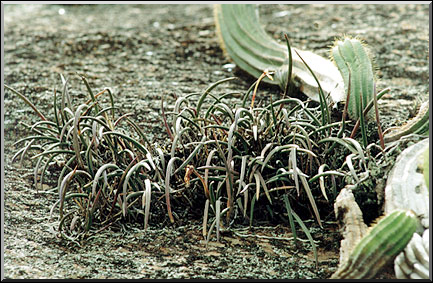 |
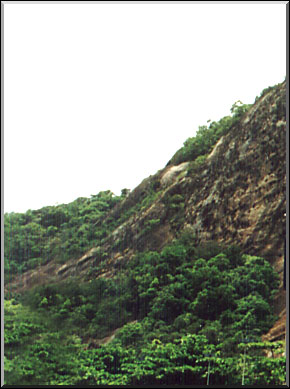 |
Just bellow and in front of this face, a small wood also helps to keep the environment humid. In the intermediate side (between that which faces the sea and that which faces the wood), it also occurs since 4m height although the population is not so richer. |
| In the past, Brassavola tuberculata has been collected in Pão
do Açúcar Hill, Pedra da Urca, na Praia Vermelha, in a mound in Flamengo
and Botafogo, in the sandbanks of Recreio dos Bandeirantes and Jacarepaguá
and in the surroundings of Rio de Janeiro city. In his study done in 1966, Pabst refers to examined matter from Pedra da Urca, Praia Vermelha (both in Urca quarter) blooming from May to June. |
| Some botanists consider Brassavola perrinii as a synonym of Brassavola tuberculata. Some others, although agreeing that they are very closer with identical flowers, think that, in the point of botanical view, they are different. If this doubt exists to the botanists, to the growers, it does not arise. To them, the differences verified are enough to separate one species to the other as a result, they give them different ways of cultivating. |
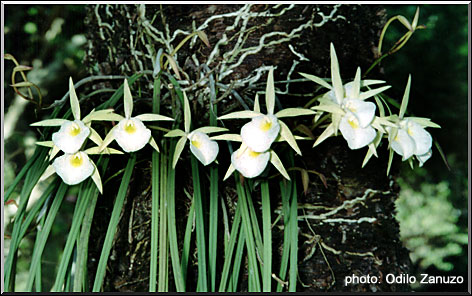 Brassavola considered as perrinii
|
| Brassavola
tuberculata seems to be more tolerant to sunbeam, the leaves are smaller in length and in thickness and presents one or two flowers in a short raceme. On the other hand, the one considered a Brassavola perrinii grows in the state of Rio de Janeiro, next to sea, in sandbanks areas but well protected by the crown of the trees and presents from 3 to 6 flowers by spike. The leaves are much thicker and longer reaching more than 25cm and, even, 50cm. In Massabamba sandbanks, in the state of Rio do Janeiro, grows as epiphyte (*) sprouting in the interior of the bushes with strong light but protected from the direct sunbeams. Anyway we can not just tell that Brassavola tuberculata is rupicola and Brassavola perrinii is epiphyte because Hoehne, who considered as two valid species, described the last one as occurring enormous granite massifs in the state of Santa Catarina Catarina (Iconografia das Orchidáceas do Brasil, page 72), as well as in area of typical cerrado (savanah) in the state of Minas Gerias, although he did not precise clearly which was the vegetative habitat in this environment (Id. page 105). Considering as synonyms and not as two valid species, the literature informs us that in the state of Rio de Janeiro, it occurs in the sandbanks of Cabo Frio and Araruama. It is also confirmed to, at least, 10 other states: Alagoas, Ceará, Espírito Santo, Minas Gerais, Pernambuco, Paraíba, Paraná, Rio Grande do Sul, Santa Catarina and Sergipe. In the state of Espírito Santo occurs all long the seaside, since the boundary with the state of Rio de Janeiro until the north with the state of Bahia (it also occurs in sandbanks areas). According to Pabst, it occurs in the I, II and III ecological provinces. Geographically, in Brazil, the province I comprehends the Serra do Mar (Mar mountains). The province II comprehends the hot regions of the seaside until Amazonas basin and is characterized by a tropical hot humid climate. The III one is located in the Central Plateau, typical region of cerrado (savannahs, plateau of the states of Minas Gerais, Goiás and Mato Grosso). We believe that is endemic to Brazil, although it has been reported (but not confirmed) from Bolivia and Paraguay. Curiously, Hoehne, in Iconografia das Orchidaceas do Brasil, talks about a hybrid of Brassavola perrinii and Laelia purpurata, in Florianópolis, in the state of Santa Catarina, in rocky areas, at 20-30m height. Pabst, in his great work, does not refer to this hybrid. In the state of Alagoas, it was verified the occurrence of a hybrid with Cattleya granulosa Lindl. registered by Dr. Luiz Pereira Araujo and published in the magazine "Orquídeas" and in the state of Pernambuco, there is a rapport of a new occurrence. This species presents a high index of natural inter-genera genera: Brassocattleya X araujoi Pabst & Mello (l977) (with Cattleya forbesii Lindl.) - Rio de Janeiro Brassocattleya X fregoniana L. C. Menezes (2000) (with Cattleya guttata Lindl.) - Espírito Santo Brassocattleya X lindleyana (Rchb. f.) Rolfe (with Cattleya intermedia Grah. ex Hook) - Rio Grande do Sul and Santa Catarina. Brassocattleya X miranda L.C. Menezes (l988) (with Cattleya warneri T. Moore) Brassocattlyea X tramandahy Hort. (with Cattleya leopoldii Verschaff. ex Lem.) Rio Grande do Sul and Santa Catarina. Considered as an easy plant to be cultivated, some cares should be taken because although it grows in direct sunbeam, stuck on the rocks, the environment if very well aerated by the marine breeze and by the drop of nocturnal temperature, protecting them from the extreme dryness or the excessive humidity. In cultivation, the environment should be have a good luminosity or slightly shaded, with a good humidity. It needs to be well watered during the growth period, with a reduction during the winter. Be careful and keep the alternation of dryness and humidity as occurs in the nature. In general, it is cultivated in slabs of tern-fern or branches with or wrinkled barks. In live trees, it grows very well in mango trees, Erythrina trees and others. If you settle it in a tree, put a small quantity of tree-fern fiber to help the initial rooting. Due to the fact that the conditions in rocks and in sandbanks are so different regarding the luminosity, it should be necessary to know the origin to provide the required luminosity, although the growers recognize the species just observing the vegetative growth. |
| Bibliography: - Revista Orquídea, Setembro-Outubro l966, página 277, G.F. J Pabst. - Ecologia, Fitogeografia e Conservação das Orchidaceae da Restinga do Estado do Espírito Santo, Claudio Nicoletti de Fraga, Pós-graduçaão em Ciências Biológicas (Botânica) da UFRJ, ano 2.000. - Jim & Barbara McQueen, Orchids of Brazil, - João Siegrfied Decker, Cultura das Orquídeas no Brasil, Secretaria da Agricultura, Indústria e Comércio do Estado de São Paulo. - Orchidaceae Brasiliensis - G. F. Pabst & F. Dungs, Alemanha, l977, Vol. I - (*) Maria da Penha Fagnani e Carlos Ivan da Silva Siqueira - "Orquídeas da Restinga", Revista Orquidário Volume 6, nº 2, l992 |
| It is expressly forbidden any kind of usage of any material of this site (text, photos, images, lay-out and any other), without the express authorization from the authors. Any kind of request or information, use the e-mail bo@sergioaraujo.com |